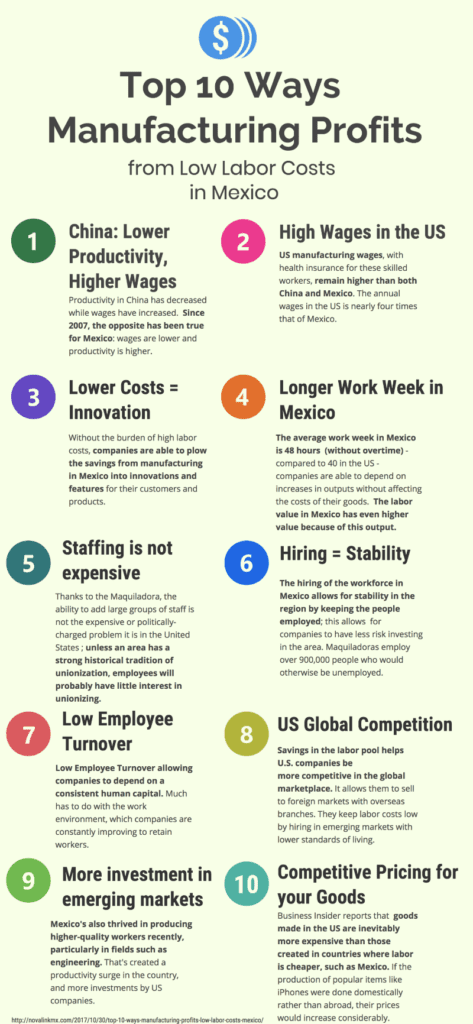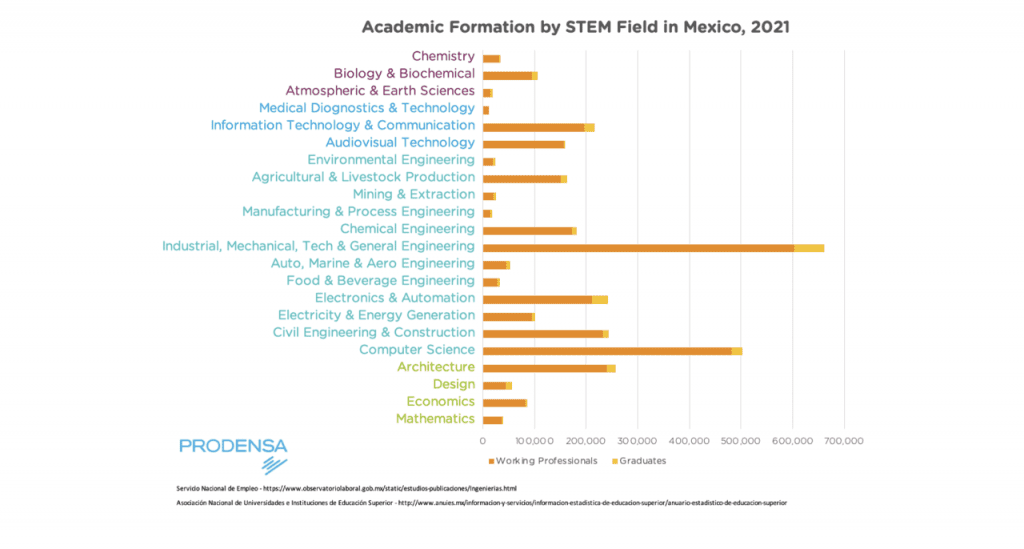Last Updated on April 24, 2025
Let’s be honest—when people talk about Mexico as a manufacturing hub, they often jump straight to lower costs and proximity to the U.S. But here’s what too many overlook: the labor force in Mexico is brimming with talent, especially in engineering. And I mean a lot of talent. Roughly 110,000 to 130,000 engineers graduate from Mexican universities every year. That’s not a typo. That’s a pipeline of problem-solvers, builders, and innovators—year after year.
And you know what? This isn’t just about having warm bodies on the factory floor. It’s about having sharp, highly trained minds behind the machines, the software, the systems. If you're thinking about relocating or starting a manufacturing operation in Mexico, the talent pool isn’t just a footnote—it’s the headline.

The Labor Force in Mexico Is Highly Educated
So, what does graduating over 130,000 engineers a year actually mean?
Well, for starters, it means Mexico isn’t just keeping up—it’s actively shaping its future workforce around high-demand fields. Think industrial engineering, electronics, robotics, and software. Over 20% of all Mexican university grads are engineers. That’s not just impressive—it’s strategic.
Mexico has an excellent educational system that promotes the development of STEM subjects (science, technology, engineering, and mathematics). Since the early 1990s, their programs have grown substantially, and the coursework is almost identical to that offered at universities in the United States.
Mexican Universities are cooperating with U.S. Ivy League Universities in order to attract more Mexican students to their graduate programs. Mexico’s top universities include The Monterrey Institute of Tertiary Education and Technology (ITESM), Anahuac University, UNAM, and Instituto Politecnico Nacional.

Bilingual Talent: A Bridge, Not Just a Bonus
Here’s something companies often overlook until it becomes painfully obvious: communication matters. Big time. And when you’ve got engineers and technicians in Mexico who are fluent in English, the whole operation runs smoother.
It’s pretty common in manufacturing to see a wide mix of employees—some with advanced degrees, others with hands-on skills and years of experience but maybe not formal education. But for those seriously chasing careers in engineering here in Mexico, learning English is often part of the deal. And not just for fun—because let’s face it, English is the unofficial language of code, CAD, and global engineering standards.
The result? You’ll find a surprisingly high number of bilingual professionals, especially among engineers and tech-savvy folks. That means fewer translation mishaps, easier cross-border meetings, and cleaner handoffs between teams in Mexico and the U.S.
But the value goes beyond just words. Bilingual employees often become cultural connectors. They help translate not just training manuals, but workplace culture—explaining holidays, customs, even subtle cues that make a team feel like a team. And honestly, when everyone's on the same page (and speaking the same language), things just click faster.
Labor Force in Mexico is Filling The Talent Gap
According to Forbes, the labor force in Mexico is a talent pool that should be taken advantage of, to help fill talent gaps:
“Shorter term, I believe that more companies can alleviate their talent gaps by thinking outside of borders and identifying great talent globally. From my perspective, it’s challenging to identify a better fit for U.S. time zones, cultural compatibility and relevant work experience than Mexico.” - Forbes
The Maquiladora industry, often staffed by a young and talented worker population with a mean age of 26 years, has demonstrated the capacity to construct sophisticated products for Mexico shelter manufacturing services.
Matching Your Production Needs with Mexico’s Workforce
Every industry has unique labor requirements, and Mexico offers a diverse talent pool to fit different manufacturing needs.
- Automotive & Aerospace: Skilled engineers and technicians trained in lean manufacturing, Six Sigma, and advanced production techniques.
- Electronics: Precision assembly workers with experience in circuit boards, wiring, and high-tech components.
- Textiles & Apparel: Artisans and skilled operators for the cut-and-sew, dyeing, and finishing processes.
- Medical Devices: Workers trained in cleanroom production and FDA-compliant manufacturing.
One of the biggest advantages is? Mexico’s workforce is highly trained and adaptable. Many manufacturers develop customized training programs to upskill workers based on specific production needs.
Because of the lower cost of production, an assumption is made that the goods must also be poor quality, but this is far from the truth: the labor force in Mexico, because of the high rate of education and skill in production, have expertise comparable to that of U.S. employees.
The TN Visa: Utilizing the Labor Pool in Mexico for the United States
It is still possible to utilize the labor pool in Mexico in the United States, even if you do not want to send your production abroad. It is possible to bring skilled workers from Mexico to the United States under a "TN Visa" in order to meet the shortage of skilled workers in your organization.
The TN visa was established as part of the North American Free Trade Agreement (NAFTA) to permit certain Canadians and Mexicans to work temporarily in the United States.
USMCA was implemented by the President Donald Trump while retaining the provisions of NAFTA regarding work visas. As long as a person meets the appropriate criteria for entry into the United States, the TN visa can be obtained by professionals in manufacturing fields, including industrial engineers, industrial designers, and other consultants.
Retention Is the Hidden Win
In many markets, especially in Asia, employee churn is brutal. You invest months training someone, and just when they’re getting good—they’re gone. It is common for factories to have staff turnover of up to 80% every year, depending on the sector, the factory, the city, or the province.
But in Mexico? The turnover rates, especially among skilled professionals like engineers, are generally much lower.
People aren’t just looking for a paycheck. They’re looking for stability, growth, purpose. Companies that treat their employees well—think safe conditions, real opportunities, decent wages—often see fierce loyalty in return.
You’re not just hiring engineers. You’re building a team that sticks around.
So, What’s the Catch?
Honestly? There really isn’t one—if you approach it right.
You’ll need to invest in onboarding. Maybe adapt some training materials. Work with local partners who know the terrain. But those are smart moves in any market. What you get in return—loyalty, talent, technical precision—is more than worth the setup.
And here’s where it gets even easier: when you partner with a nearshore manufacturing company like NovaLink, a lot of that heavy lifting is already built into the relationship. NovaLink knows the local systems, understands the workforce, and can help streamline everything from hiring to training to compliance. Instead of going it alone, you’re tapping into a team that’s been there, done that, and knows how to fast-track your transition without cutting corners. It's not just a shortcut—it’s a smarter way to scale.
Wrapping It Up
The labor force in Mexico isn’t just deep—it’s skilled, young, and getting smarter every year. With over 130,000 engineers graduating annually, companies aren’t wondering if they can find talent—they’re asking how fast they can get started.
So, if you’re thinking about setting up shop in Mexico, don’t just focus on the cost savings or logistics. Look at the people. Look at the minds. They’re the ones who’ll power your growth—quietly, reliably, and brilliantly.
FAQs on The Labor Force in Mexico
- Is Mexico known for having a skilled labor force in engineering? Yes, Mexico is known for having a skilled labor force in engineering. The country produces more than 130,000 engineers annually, which contributes to a pool of highly qualified professionals in various engineering disciplines.
- What types of engineering programs are available in Mexico? Mexico offers a wide range of engineering programs across different disciplines. Some of the popular engineering fields include mechanical engineering, electrical engineering, industrial engineering, civil engineering, chemical engineering, and automotive engineering.
- Are Mexican engineering graduates well-prepared for the industry? Mexican engineering graduates are generally well-prepared for the industry. The country's engineering education system focuses on providing students with a strong foundation in theoretical knowledge as well as practical skills through internships, laboratory work, and industry collaborations. Many universities in Mexico have programs tailored to the needs of the industry, ensuring that graduates possess the necessary skills and knowledge to excel in their engineering careers.
- How does the number of engineering graduates in Mexico compare to other countries? Mexico's annual production of over 130,000 engineering graduates places it among the top countries globally in terms of engineering education. The country has made significant investments in higher education and engineering programs to meet the demand for skilled engineers in various industries.
- What are the advantages of hiring Mexican engineers for manufacturing operations? Hiring Mexican engineers for manufacturing operations offers several advantages, including:
a) Cost-effectiveness: Mexican engineers typically offer competitive salaries compared to engineers in other countries, providing cost savings for manufacturing businesses.
b) Proximity to the United States: Mexico's geographic proximity to the United States makes it convenient for companies that have manufacturing operations or customers in the U.S., reducing logistics costs and enabling efficient collaboration.
c) Strong technical skills: Mexican engineers are known for their technical expertise and strong educational background, allowing them to contribute effectively to complex manufacturing processes and innovative projects.
d) Bilingual capabilities: Many Mexican engineers have proficiency in English, enabling seamless communication with international colleagues, clients, and suppliers.
e) Cultural compatibility: Mexican engineers often possess a strong work ethic, adaptability, and a collaborative mindset, which aligns well with the expectations and work cultures of many manufacturing companies.
6. How does Mexico’s engineering talent compare to other countries?
Mexico produces more engineers annually than the U.S. on a per capita basis. Many graduates come from internationally accredited programs and are trained to global standards.
7. Are Mexican engineers fluent in English?
Many engineering grads in Mexico receive training in English or take courses taught in English, especially at top institutions. Bilingual professionals are common in tech and manufacturing hubs.
8. What industries benefit most from Mexico’s labor force?
Automotive, aerospace, electronics, medical devices, and industrial equipment manufacturers have seen huge benefits from Mexico’s skilled labor—especially in engineering and technical roles.
9. Is it hard to find engineering talent outside major cities like Monterrey or Guadalajara?
While major cities have deeper talent pools, many mid-sized cities in Mexico also have technical universities and specialized training centers that feed local industry with skilled professionals.
10. How can companies retain skilled workers in Mexico?
Retention in Mexico is generally stronger than in many offshore locations. Companies that invest in training, pay fairly, and offer real career paths tend to see long-term loyalty and low turnover.
Explore More: Discover Related Blog Posts
Expand your knowledge and delve deeper into more information about Mexico Labor with our curated collection of related blog posts.
- Mexico Rewards Manufacturing Companies That Commit: Here’s Why
- Can Moving Manufacturing to Mexico Really Be Turnkey? Here’s What You Need to Know
- 3 Hidden Costs You’re Avoiding by Manufacturing in Mexico (And Why It Matters)
- Setup Process for Manufacturing in Mexico: What You Should Know About Timelines, Permits, and Common Pitfalls
- How U.S. Tariffs Are Reshaping Mexico’s Manufacturing Outlook
- Car Brands Made in Mexico: A Look at Global Manufacturing Powerhouses
- 4 Factors That Affect Your Manufacturing Costs in Mexico (And How to Stay Ahead)
- Americans Say They Want More U.S. Factory Jobs—So Why Don’t They Want to Work in Them?
About NovaLink
As a manufacturer in Mexico, NovaLink employs a unique approach that transcends the traditional model of shelter production. More than just the location of your manufacturing, we would like to become a partner in your manufacturing in Mexico. You will be able to relocate or initiate manufacturing for your company in Mexico in a low-cost labor environment with very little delay or up-front costs. Find out how we can help you by handling the manufacturing process.
There are NovaLink facilities in the border cities of Brownsville, Texas, Matamoros, Mexico, and Saltillo, Mexico.